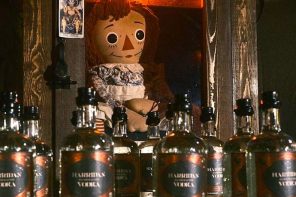In May, four girls at a Colombian high school experienced a supernatural encounter so profound they had to be taken to the emergency room in an ambulance.
The girls had been playing a game called the “Charlie Charlie challenge” in which teenagers use two precariously balanced pencils to conjure an ambiguous entity named “Charlie.” Players ask Charlie questions and Charlie answers by moving a pencil to point at one of four answers written on a sheet of paper.
Around Memorial Day weekend, the game went viral on Twitter with the hashtag #CharlieCharliechallenge appearing more than two million times in less than a week. Charlie has been spinning pencils throughout the Americas and even as far away as Palestine. Numerous videos of the game show shrieking teenagers flee the room as soon as the pencil begins to move.
Religious authorities, psychologists, and new media experts have all stepped forward to explain the phenomenon. Last week, HNGN raised the alarm that this is the “new Slenderman craze.”
As a religion scholar, it seems to me the appeal of the game is a desire for a direct contact with mysterious forces.
Folklorist Bill Ellis has suggested that the Ouija board—an obvious forerunner to Charlie—is a kind of ritual in which adolescents test religious worldviews by provoking an encounter with the supernatural. This perspective allows us to understand how claims about the nature of the game affect its appeal.
The decision to summon Charlie is not based in the logic of spiritual good and evil, but rather of enchantment and disenchantment. Figures such as Pat Robertson have claimed Charlie is a demon, which only enhances the game’s status as a supernatural ritual.
Others have claimed the game is a viral marketing ploy for a horror movie. This move kills Charlie’s appeal by aligning him with the banal forces of capitalism.
Charlie’s origins are ambiguous. The website “Know Your Meme” discovered a video from June 6, 2014, called “Jugando Charly Charlie” featuring a version of the game using six pencils instead of two. Some sources claim versions of this game have been played in Spain for generations.
In April 2015 a TV station in the Dominican Republic aired a story portraying the Charlie game as a Satanic threat taking over schools. The footage went viral, spreading the game’s popularity to other countries.
Although Charlie is most often described as a “Mexican ghost,” it appears that Christian critics reframed the game as Satanic almost immediately. It is in the interest of religious institutions to claim a monopoly on wholesome encounters with the supernatural.
As early as the 2nd century, Christian writers such as Tertullian claimed that pagan mediums who claimed to speak for the gods were actually experiencing demonic possession. In the 19th century Spiritualism became popular and many Christians claimed that the “ghosts” appearing at séances were actually demons.
When the Ouija board became popular after World War I, the Catholic Church made efforts to suppress “experimenting” with the board. So it is hardly surprising that Catholic priests, including the famous exorcist Jose Antonio Fortea, have condemned Charlie as demonic.
Muslim clerics in several countries also have weighed in, speculating that Charlie could be a dangerous jinni.
However, branding Charlie as a demon appears only to make him more appealing. Ellis notes that use of the Ouija board has a structure similar to exorcism, in which an entity is called forth, named, questioned, and then dismissed.
The Charlie Charlie challenge eschews some of these elements because the conjured entity is already identified and the game/ritual does not allow for open-ended responses. And yet the ritualistic opening and closing remain.
Players emphasize it is important to begin with an invocation such as “Charlie, Charlie are you here?” and finish with the question, “Charlie, Charlie can we stop?”
Ellis suggests that adolescents use these rituals to conjure an “antiworld” that they can challenge and reject. Frightening encounters with the supernatural allow adolescents to “participate directly in myth” rather than hearing about it in church. These rituals may also tighten social bonds by creating a sense of communitas between the participants.
The way to discourage teens from summoning Charlie is not to frame their ritual as demonic but as inauthentic. On June 1, just after the phenomenon peaked, the website Uproxx announced that the entire affair had been a marketing ploy for a horror movie called The Gallows. (A trailer for the film shows children playing the game).
Subsequent articles analyzing the chronology of this claim have suggested that the film did not actually invent the Charlie Charlie craze but rather attempted to ride its appeal.
What is significant about this debate is the tone of disillusionment and despair in the articles announcing the game is a marketing tactic. Uproxx ran the headline, “#CharlieCharlieChallenge Was A Viral Marketing Campaign Because Everything Is Terrible.” Seventeen magazine’s coverage demanded, “Is Anything Sacred?!”
Sacred indeed.
Whatever else the Charlie Charlie phenomenon is, it demonstrates a longing to step outside a disenchanted world where the logic of the market rules and our hopes and dreams amount to market demographics.
A terrifying demonic encounter at least would confirm that there is something real beyond a world dominated by media and simulacra.





